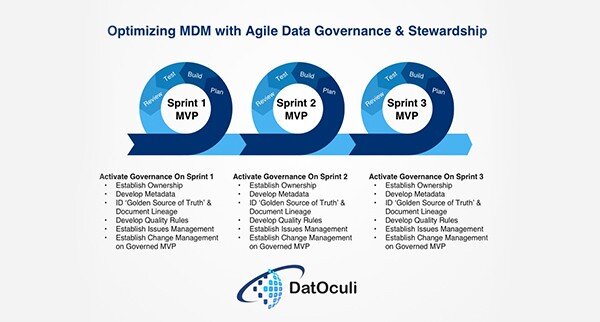Optimizing MDM with Agile Data Governance
With multiple regulatory compliance initiatives such as Anti-Money Laundering (AML) and other counter-terrorism acts, the need for a 360-degree view of our customers is a 'must-have'.
You must know who your customers are and where they've been, not only at the point of engagement and onboarding but throughout your ongoing relationship with them as an entity.
You must get intimate with their transactional behavior so that you may better serve them and identify potential risks around suspicious activities that could expose your organization at the same time.
As a direct response to the demand for a single customer view, coupled with internal pressures for market growth, Master Data Management (MDM) has emerged at the forefront of many organizations' strategic initiatives in recent years.
Extending this to product data provides a significant advantage beyond regulatory obligations as it helps to accelerate business growth.
But with so much poor data quality and untrusted data in our ecosystems, maintaining duplicate and redundant data over the years has cost organizations dearly and acted as a brake on potential business growth.
Not having a 360-degree customer view has made it difficult for organizations to answer simple basic questions such as:
How many customers do we have?
What is the correct definition of a customer?
Who are our most profitable customers?
What is the lifetime value of a typical customer?
The embarrassing truth is that most organizations cannot answer these seemingly simple questions, at least without serious effort.
And it gets worse.
Many organizations have been reporting erroneous customer figures as different silos and lines of business fail to work cohesively to manage their master data assets.
A recent example in the news is the overstated numbers reported by Ted Baker:
Ted Baker probes £25m stock inventory blunder
The annual cost and impact of data quality issues that are rooted in ungoverned data with little or no formal accountabilities around critical enterprise data have propelled the need for many organizations to fix their MDM problem.
It's evident that the need for 'trusted data' continues to show up in all of our recent data initiatives. However, most organizations are still struggling with their MDM rollout simply because it's being handled from a one lens angle. It's one thing to fix the problem by mastering our bad data; it's another thing to make the solution sustainable by treating the root problem at the heart of introducing the same problem to our data echo system.
The value of 'Stewardship culture' around our data assets cannot be overemphasized.
For MDM to be sustainable and rightfully implemented, it must be positioned in a governed environment where stewardship around the Mastered Data, and the associated culture required to lock in the gains, are both implemented.
Here are some questions to consider...
· Could this be the reason why you're finding it hard to sustain your MDM rollout or are you stalling because of the same?
· Is your organization incorporating Data Stewardship and Governance into your MDM deployment strategy?
· Are you intentional about changing the bad behavior around your data that created the same problems in most of your organizations?
· Are you building communities of data stewards and cumulative responsibilities around your enterprise data through your Data Governance activities?
· Or are you rolling out your MDM without a Stewardship/Governance culture of due diligence around your mastered data?
These could be some of the most critical questions you need to ask before diving into your MDM strategy.
As we continue to position MDM as one of the most important initiatives for advocating trusted and business-ready data, we must address the reality that creating a single source of truth through de-duping duplicates and removing redundancies through a sophisticated MDM match and merge can only solve half the problem.
Embarking on MDM as a singular initiative does not address the root problem of bad data creation and poor accountability in an ungoverned data environment.
For the ROI of your MDM efforts to be fully realized, you must incorporate Data Stewardship and Governance into your MDM rollout strategy. Data Stewardship & Governance naturally optimizes the sustainability of an MDM rollout.
On a personal level, this is the realization we had three years ago in a Financial Institution after several attempts trying to Master our Customer data. I spent three years leading Stewardship & Governance around MDM in a highly regulatory environment. I can attest to the success story behind this and the limitless ROI quickly realized by simply harmonizing Data Stewardship and Governance around our MDM initiative. This will not only accelerate your MDM deployment, it may also serve as an excellent way to kick off your Data Governance initiative and showcase quantifiable ROI for funding and buy-in from your executives. This also gives you a great platform to monitor your overall data maturity as an organization with a high visibility project like MDM.
MDM with Data Stewardship and Governance incorporated is a win-win because it points the organization in the right direction for creating a data-driven culture.
If you're wondering how you can pivot or position your MDM for success, I would highly recommend these two takeaways based on my success of deploying MDM in a highly regulated financial environment:
1. Incorporate Data Stewardship into your MDM Strategy - it will accelerate both your MDM delivery and Data Governance adoption
2. Go Agile with your Data Governance Approach - you'll be able to show faster value which fosters greater trust and buy-in
Why Agile Governance?
Irrespective of where you are in your MDM deployment journey or your Data Governance adoption, I recommend Agile Governance Deployment (thin slice or deep dive).
Don't boil the ocean, be strategic with your delivery roadmap, don't over-promise, be realistic with setting expectations (sprint by sprint). Start small and show values should be your mantra on this.
Choose the agile option most suitable for your organization's overall business goals and competing data demands.
In our case, we chose to deploy 'Thin Slice' governance around our MDM Most Viable Products (MVP).
Based on our Prioritization Framework, KYC ranked highest as our 'P1' MDM governance data set and that was where we started governance.
The following are some of the high-level tips and takeaways I'll recommend based on the above to help jump-start Agile Governance:
· Review your organization business goals & data demand and align your agile delivery to the same
· Build a prioritization framework around your business goals and data demand
· Identify & Review your MDM Data sets and CDEs
· Rank & Prioritize governance of your MDM data based on competing demands in your prioritization framework
· Choose your Most Viable Product (MVP) as your top dataset to govern.
· Prioritize remaining data set into groups of P1, P2, P3 based on your defined framework
· Decide and pick your agile approach based on organization data maturity level
· Execute and measure value for each delivery accordingly.
Agile Governance Options
'Thin Slice' Agile Governance around MDM:
With this, you have an option to build your roadmap deploying Governance by iterative increments of data sets starting with your MVP data.
You might choose to implement your stewardship 'standards of care' efforts (ownership, metadata, lineage, quality & issues management) for governance at the 'Basic' Maturity Level.
Depending on where your organization's Data Maturity level are when you kickoff your MDM this option gives you the flexibility to engage and start building communities of stewardship around Ownership, Metadata Management, Lineage Management, Data Quality Rules & Issues Remediations at a minimal level on a selected critical data set to hit the ground running and increase maturity level and range of scope over time.
You will be positioned to build a stronger case around funding and executive buy-ins with this approach as it provides some tangible successes to showcase.
'Deep Dive' Agile Governance around MDM:
This is a similar approach where you choose to adopt a more matured governance around your MVP data in an iterative manner by deepening the maturity level of the same set of data over time before expanding out the scope of data reach.
With the 'Deep Dive' approach, the data set to govern is relatively small and scope is focused on the MVP (Most Viable Product) deemed most critical to the enterprise strategic goal.
The governance maturity level around the scoped data in this example is usually at a much higher level. This is recommended where the optimal maturity of the same data set is desired at an accelerated rate.
In Summary
Either way, these two options are great sellers and provides an unparalleled opportunity to leverage your investment in MDM to accelerate your Data Governance.
It will also help showcase the values of anchoring your MDM initiative and Data Governance to realize a win-win ROI for your organization's other competing trusted data demands.
Want to learn how to optimize your MDM delivery with Agile Data Governance OR how to leverage your investment in MDM to accelerate Data Governance? Need some help to make your investment in Data Infrastructure a win-win success for all your competing regulatory & market demands?
We can help accelerate your success. Book a free Discovery Call with Lara Gureje:

